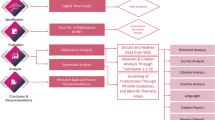Abstract
Many state and local agencies have begun to adopt computer technology as a means of upgrading existing mapping and related practices. These agencies are faced with the dualism of wanting modern technology within a traditional setting and demanding technological independence at the same time. This article is an account of the art of technology transfers, with discussions about the necessary ingredients and constraints in the identification, adaptation, absorption, implementation, diffusion, and evaluation of new technologies. In general, a systematic approach towards the strengthening of endogenous capabilities with sufficient provision for operational and policy changes may be preferable to the idea of comprehensive planning.
Similar content being viewed by others
Literature cited
Calkins, H. W. 1982. A programmatic approach to geographic information system design. Pages 92–102in D. Peuquet and J. O'Callaghan (eds.), Proceedings, US/Australia Workshop on design and implementation of computer-based geographic information systems. IGU Commission on Geographic Data Sensing and Processing, Amherst, New York.
Dangermond, J., and C. Freedman. 1984. Ontario user needs studies—a description of the project methodology and analysis procedure. Environmental Systems Research Institute, Redlands, California.
Dangermond, J., B. Derrenbacher, and E. Harnden 1984. Description of techniques for automation of regional national resource inventories. Pages 50–81,in B. J. Niemann, Jr. (ed.), Wisconsin land information reports, No. 1, Institute for Environmental Studies, University of Wisconsin-Madison
Lai, P. C. 1988a. Resource use in manual digitization: A case study of the Patuxent Basin geographic information system: data base.International Journal of Geographical Information Systems 2(4):329–345.
Lai, P. C. 1988b. Maryland Department of Natural Resources Patuxent Basin geographic information system: A pilot experience and some recommendations for future efforts. Land Planning Services, Maryland Department of Natural Resources, Annapolis, Maryland, May 1988.
Lai, P. C. 1988c. Maryland Department of Natural Resources Patuxent Basin geographic information system: Data base descriptions and sample applications for natural resource management. Land Planning Services, Maryland Department of Natural Resources, Annapolis, Maryland, May 1988.
Lai, P. C. 1989a. How would you evaluate your geographic information systems? GIS/LIS Columns. ACSM Bulletin, No. 121 (August 1989), pp. 51–52.
Lai, P. C. 1989b. 3-dimensional land planning and modelling capabilities, Report #3, Contract No. STMD MD DEPT NAT RES 01-4-30482, Maryland Department of Natural Resources, Annapolis, Maryland, June 1989.
Lai, P. C. 1989c. Maryland natural resource map library, Report #2 Contract No. STMD MD DEPT NAT RES 01-4-30482, Maryland Department of Natural Resources, Annapolis, Maryland, May 1989.
Lai, P. C. 1989d. Deep Creek Lake management information system, Report #1, Contract No. STMD MD DEPT NAT RES 01-4-30482, Maryland Department of Natural Resources, Annapolis, Maryland, April 1989.
Meyer, R. W. 1990. Management, costs, and behavioral issues with locally mounted databases.Information Technology and Libraries 9(3):226–241.
Middlestead, J. A. 1987. Developing a project plan—definition and schedule.Proceedings of the AM/FM Conference X 1:205–213.
Nystrom, D. A., B. E. Wright, M. P. Prisloe, and L. G. Batten. 1986. USGS/Connecticut geographic information system project.Proceedings of the 1986 ACSM Conference 3:210–219.
Samli, A. C. 1985. Technology transfer: The general model. Chapter 1,in A. C. Samli (ed.) Technology transfer: Geographic, economic, cultural and technical dimensions. Quorum Books, Westport, Connecticut.
Segura, E. L. 1985. Guidelines for evaluating the management information systems of industrial enterprises. World Bank Technical Paper, No. 47, Washington, DC.
Tomlinson, R. F., H. W. Calkins, and D. F. Marble. 1976. Computer handling of geographical data: An examination of selected information systems. The UNESCO Press, Paris.
United Nations IDO (Industrial Development Organization). 1981. Technological Self-reliance of the developing countries: Towards operational strategies. Development and Transfer of Technology Series, No. 15.
Author information
Authors and Affiliations
Rights and permissions
About this article
Cite this article
Lai, P. Issues concerning the technology transfer of geographic information systems. Environmental Management 15, 595–601 (1991). https://doi.org/10.1007/BF02589619
Issue Date:
DOI: https://doi.org/10.1007/BF02589619




